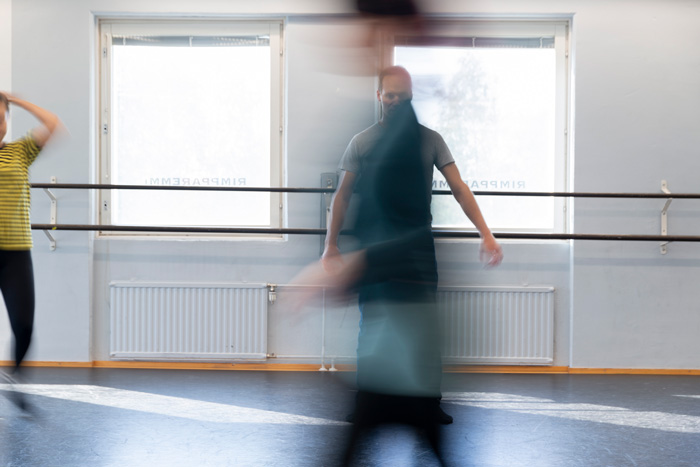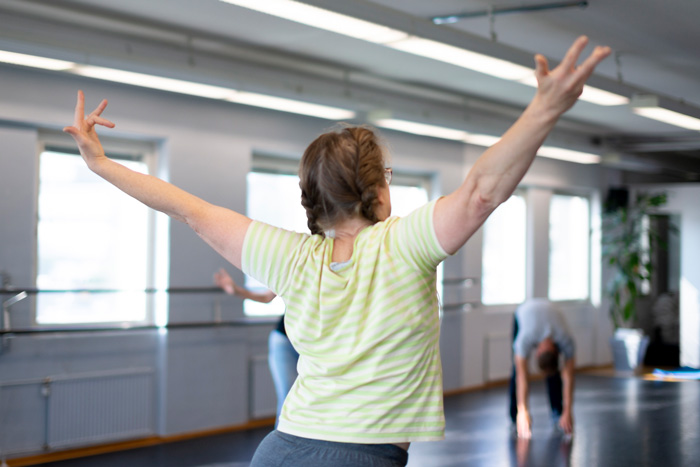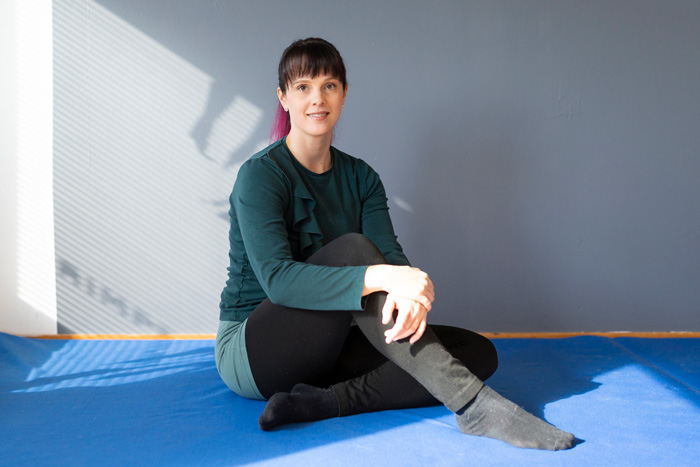Methods based on dance and movement therapy may open up new ways to develop organisations and wellbeing at work. Thereby a person is considered an entirety consisting of the body, mind, and social dimensions, not just a rational mind.
A wave moves through my spine. It moves my whole body, even though my feet are rooted in the floor. The coach's voice asks me to concentrate on my shoulders, to explore the many ways in which they could move. I roll my right shoulder forward, the left one backward. A hiss emanates from my breastbone. I wonder what this may look like. Luckily, all the others have their eyes closed too, I'm safe, nobody can see me. Oh, except for those cameras.
I am in a dance hall with six colleagues, attending a workshop arranged for us by Pauliina Jääskeläinen, a dance and movement therapist and a doctoral student at the University of Lapland. During the workshop, we get a chance to try out a few embodied methods. We have started by examining movement in various parts of the body.
Jääskeläinen studies embodiment in the development of organisations. "In my dissertation, I study what the use of embodied methods, especially dance and movement therapy, can bring forth in an organisation. In addition, I discuss the application of the methods in developing work, wellbeing at work, and the operation of organisations and in advancing the goals of organisations and work communities," Jääskeläinen notes.
Dance and movement therapy started to develop concurrently with modern dance in the US of the 1950s and '60s. Today, it is applied to many types of activity to increase wellbeing, self-awareness, development, and learning.
If you have thought dance involves strict choreographies, think again: Dance and movement therapy interprets dance to include all human movement. You do not have to know how to dance or how to move in a specific way, because all movement, or the lack of it, is permitted. The basic assumption is, however, that as your movements become more versatile, you also accrue ways to cope in everyday situations of interaction.

The body, the mind, and social dimensions
I've entered the realm of slow movement. At the other end of the hall, in the realm of fast movement, people are dashing around. It looks silly. What's the hurry? Just a while ago, I was rushing around in the realm of fast movement. I was annoyed by the sluggishness of the people in the realm of slow movement. "Why are they loitering about?" the judge in my ear demanded.
In the core of dance and movement therapy lies the conception of the human being as an entirety formed by the body, the mind, and social dimensions.
“We all have our individual ways to move that are directly connected to our minds and personalities, signalling something about ourselves to the outside. We may learn to know ourselves, our ways of thinking, and our ways of interacting with others better by examining our movement and by focusing on the bodily sensations created by it,” Pauliina Jääskeläinen says.
“The moving body enables you to notice things previously hidden inside you and to try out new ways of thinking and acting. It may be an easier and faster way than mere talking and rationalising. Thereby movement enables change and human growth,” she adds.
As for work communities, dance and movement therapeutic group instruction enables you to approach your workmates from new angles and to understand them better. Understanding forms a basis for communion and empathy.
“For example, each of us has a personal rhythm of doing things. Different rhythms may create problems in a work community when those with a faster pace have trouble understanding slower ones and vice versa. It is often easier to address these problems through movement than through a verbal account of your own experience,” Jääskeläinen notes.
Professional guidance through the body
According to Pauliina Jääskeläinen, embodied methods are one way of implementing professional guidance in a community, as they enable one to observe and change activities. For the purposes of her dissertation, she has conducted group meetings focusing on embodied facilitation of wellbeing in three social- and health-sector organisations. In addition, she has organised three individualised workshops on embodied professional guidance for leaders.
Jääskeläinen notes that in a group context, the facilitation is ideally suited to work communities consisting of less than ten people. “It is of utmost importance that there is an atmosphere of trust in the group. It may be difficult to create in larger groups, especially if the each session has new participants,” Jääskeläinen says.
If the process is to be used to genuinely develop the activities of a community, it requires long-term commitment and the integration of embodied professional guidance into the overall development of the organisation. It is also important that the group be allowed to decide on the concrete goals of the work community that will be pursued through the facilitation, even though the process is commissioned by the management. In practice, the method can be used to reach a wide variety of goals.
“Based on experience I believe that when an individual and a group set a goal for themselves, they start to realise it also subconsciously during the process,” notes Jääskeläinen.

Excessive rationalisation
According to Pauliina Jääskeläinen, the Western work culture typically values a rational mind only. As a therapist and a researcher, she finds this hard to swallow.
“Although we are entities consisting of the mind, the body and social dimensions, these facets are treated as separate. Workplace wellbeing programmes usually focus either on instrumental treatment of the body or on discussion. Services combining all human facets are not offered to employees,” Jääskeläinen notes.
She would like to see more embodied methods available for supporting wellbeing. Perhaps it would help people rediscover their innate movement. “For example in Finland, dance is considered an elitist skill that requires special traits. Being able to move freely is a strange idea for many,” Jääskeläinen laments.
Dance and movement have always been a part of her life. She has engaged in ballet and flamenco dancing and worked as a dance instructor. That said, her relationship with dance and movement has been somewhat complicated: The styles that she knows so well are very technical and demanding, and because of them, she has learnt to be too tough on herself.
“Nevertheless, I still regard dance and movement as something very unique. Nothing compares to the state that you can reach by letting yourself go and enjoying your own movements. It is a catharsis enabling you to live your embodied emotions and experiences through movement.”
The sun caresses my legs. I’m lying on the floor, my breathing flows from the centre of my body to my right leg and back again. My hip feels tight, it won’t settle on the floor. The judge within me spits out words of reproach. I remain listening to the clatter of the camera. I decide to accept them, as part of this space and time. Gradually, my whole body relaxes and presses against the floor. All is quiet.

Pauliina Jääskeläinen studies embodiment in the development of organisations in her dissertation at the University of Lapland.
Dance and movement therapy
- A form of art therapy used in rehabilitation and to support wellbeing, development, and learning
- Perceives dance comprehensively as any human movement
- Observes situations, feelings, and thoughts through various embodied methods